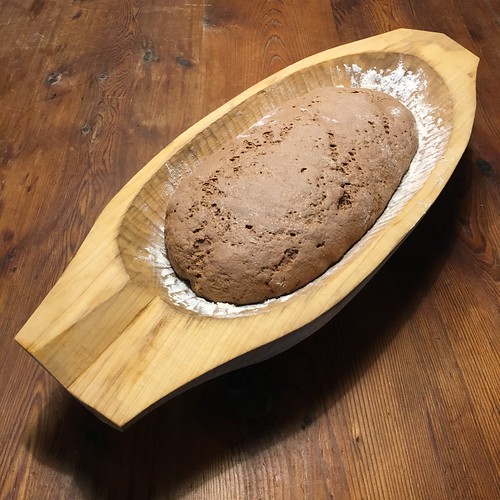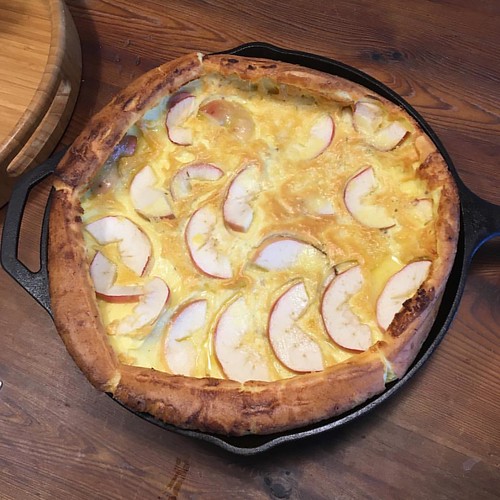I have given this recipe out often enough recently that it ought to be written out here. This is our weekly to semiweekly country bread. We have two smallish bannetons, so I usually divide it into two loaves, though sometimes I braid it and proof it as a single loaf in our big wooden proofing bowl. This is a slow, slow sourdough. If I start this the moment I get home from work, it is usually ready for Jami and the boys to eat by lunch time the next day. That is not to say that it is particularly labor intensive, just slow. Other than that it is fairly forgiving, tastes great, and is decently sliceable for several days out on the counter (though never better than right out of the oven), and decidedly un-fancy.
Ingredients:
- 1 cup rye flour
- 1 whole wheat flour
- 2 cups white flour
- 2 cups filtered water
- 2 tsp salt
- 1 cup sourdough starter
- 1 tablespoon olive oil or other fat (only if needed to oil the container for bulk fermentation)
- extra white flour for kneading and shaping later on
- a small handful of cornmeal, grits, or semolina for the stone (whatever is around)
Equipment
- stand mixer with dough hook
- measuring cups
- large bowl for proofing
- 2 bannetons or other vessel designed to shape and structure the loaf while proofing (this is a fairly loose dough, and will form a sad puddle of bread without some guidance)
- large baking stone
- wooden or plastic spatula
- bench scraper
- clean kitchen towel
- bread lame or sharp knife
Day 1: mixing and proofing
1. Make sure starter has been fed and is active at least two hours before beginning.
2. Blend the flours in the mixing bowl, mix in 1 1/2 cups of water, and autolyse for 2 hours (this allows enzymes in the flour to begin breaking the starches down into sugars, rye is very good at this).
3. After 2 hours add the remaining 1/2 cup water with salt dissolved into it.
4. Add starter.
5. Knead on dough hook for ten minutes, stopping occasionally to scrape any of the drier flour mixture from the bottom of the bowl and incorporating it more fully into the dough.
6. Transfer to large oiled bowl and cover with a damp towel for 2-3 hours for bulk fermentation in a reasonably warm part of the house.
7. Pull dough out onto a floured surface to divide and shape into loaves.
8. Place loaves into well floured bannetons.
9. Cover bannetons with a damp towel and place in refrigerator to retard (ferment slowly) overnight.
10. It's probably close to midnight now. Go to bed.
Day 2: baking
1. Remove bannetons from the refrigerator, rewetting the towel if necessary.
2. Allow loaves to sit until nearly doubled in bulk from their original size after shaping, keeping in mind that they may have risen somewhat overnight. This is highly temperature dependent. The loaves are obviously cool, and if the house is cool they will warm more slowly and continue to rise more slowly still.
3. Begin preheating stone to 500 ºF (260 ºC) about 30 minutes to 1 hour before baking.
4. Once the loaves are ready, sprinkle some polenta or semolina onto the stone (to prevent sticking), and dump the loaves out of the bannetons onto the stone, slashing the tops once they are in place.
5. Splash some water in the oven if you prefer a harder crust.
6. Bake at 500 ºF (260 ºC) for 10 minutes.
7. Reduce heat to 350 ºF (177 ºC), and bake for 25 more minutes (or longer for a darker crust since that seems to be in vogue nowadays).
8. Bread should sound hollow when thumped on the underside if it is fully cooked.





